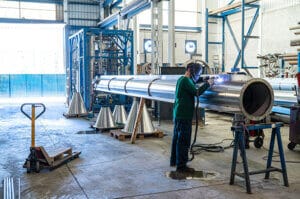5 Reasons Companies Are Nearshore Manufacturing to Mexico
10.06.21 The manufacturing industry is ever-evolving, and there’s been a particular shift that’s picked up steam over the past several years. U.S. and other foreign companies are moving or expanding their operations to Mexico at an increasing rate. They join several of the top global leaders in the manufacturing industry that have benefited from the advantages of nearshoring to Mexico for decades.
The manufacturing industry is ever-evolving, and there’s been a particular shift that’s picked up steam over the past several years. U.S. and other foreign companies are moving or expanding their operations to Mexico at an increasing rate. They join several of the top global leaders in the manufacturing industry that have benefited from the advantages of nearshoring to Mexico for decades.
Despite this increase, navigating post-pandemic shutdowns has left many remaining in a gray area of how best to proceed. However, Mexico continues to be a viable option with minimal risk and optimal reward, particularly when compared with offshoring to China. Here are five reasons companies are nearshoring manufacturing to Mexico as part of their strategic operations.
#1: Talent Level and Employee Availability
In early 2021, it was reported the manufacturing skills gap in the U.S. could result in 2.1 million unfulfilled jobs by 2030. Over a million U.S. manufacturing jobs were a casualty of the Covid-19 pandemic and recouping that loss has been slow due to ongoing difficulties attracting and retaining workers in America. Whereas, in Mexico, the availability of highly skilled talent has always been the main driver for companies that need to hire technical talent.
Over 110,00 engineers graduate in Mexico every year. There are incentivized specialized training programs designed to get more people qualified to work in advanced technical industries. Plus, companies can benefit from a young working population; the median age for manufacturing industry employees in Mexico is 27-28. With an emphasis on education and training programs in collaboration with U.S. and other foreign manufacturers operating in Mexico, the level and availability of talent is a consistent resource much needed in today’s industrial environment.
#2: Competitive Costs
A second reason foreign companies are choosing nearshoring manufacturing to Mexico is competitive costs. This includes everything from labor to tax exemptions to costs associated with shipping times and quality assurance. As an example, per Statista, estimated manufacturing labor costs in Mexico start at $4.82 per hour compared to $6.50 per hour in China and $7.25 per hour in the U.S., which is the current federal minimum wage.
Additionally, Mexico’s maquiladora/IMMEX program offers tax exemption from the 16 percent VAT when importing raw goods, materials, and equipment for the manufacturing process. For companies that choose to operate under a shelter, this offers a significant cost advantage that begins from the first day of operation. These are only two of the many areas of cost-effectiveness when nearshoring to Mexico and working with a shelter, specifically.
#3: Proximity and Location
A significant advantage for U.S. manufacturers is proximity and location. Rather than operating facilities overseas in China or other Asian countries, many companies can operate on the same time zone and with much easier access when nearshoring to Mexico.
The close proximity of U.S. headquarters and final market destinations to the U.S.-Mexico border results in quicker shipping times and less expensive shipping costs. An operational setup in one of Mexico’s border cities is often able to ship finished goods within 48 hours, if not the same day to their U.S. destination. Whereas, the same type of shipment could take weeks to receive from China and cost thousands of dollars more.
#4: Free Trade Agreements
Mexico’s free trade agreements are another incentive that entices foreign manufacturers. Mexico maintains 14 free trade agreements with over 50 countries, including the USMCA with the U.S. and Canada. The USMCA offers protections and provisions for North America trade, such as the rules of origin regarding automotive content and greater intellectual property (IP) protection.
IP protection has been an ongoing challenge between the U.S. and China. With technology quickly evolving, having specialized protections in place are important for manufacturers who wish to develop their products in a foreign country. Since the U.S. and Mexico have maintained a favorable trade relationship, it’s more encouraging for companies that are ready to expand their operations or move them from China.
#5: Challenges with China
For decades, China was the go-to source for international trade, particularly for the U.S., mostly because of its cheap labor cost. However, in more recent times, there has been hurdle after hurdle, which has caused companies to rethink their current strategies and future plans.
These problems first started in 2018 with the trade conflict between the U.S. and China that resulted in rising and retaliatory tariffs increasing the costs of operation. Then, the pandemic hit in 2020 and halted the supply chain, which has been slow to resume. U.S. manufacturers saw the negative implications of relying solely on China for outsourced production and have since focused efforts on either diversifying or leaving China altogether and setting up closer to home.
Overall, nearshore manufacturing to Mexico delivers a favorable solution on multiple levels. Significant turning points in the manufacturing industry don’t always happen all at once. They often start small and then gain momentum due to a sequence of events that requires companies to pivot, which is what’s happening at the present moment.
For more information about nearshore manufacturing to Mexico and its unique advantages, contact IVEMSA today.
Sources:
https://www.nam.org/2-1-million-manufacturing-jobs-could-go-unfilled-by-2030-13743/?stream=workforce
https://www.statista.com/statistics/744071/manufacturing-labor-costs-per-hour-china-vietnam-mexico/
